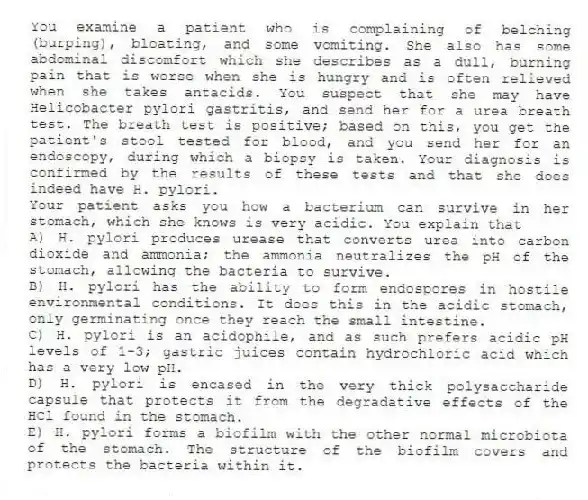
You examine a patient who is complaining of belching (burping) , bloating, and some vomiting. She also has some abdominal discomfort which she describes as a dull, burning pain that is worse when she is hungry and is often relieved when she takes antacids. You suspect that she may have Helicobacter pylori gastritis, and send her for a urea breath test. The breath test is positive; based on this, you get the patient's stool tested for blood, and you send her for an endoscopy, during which a biopsy is taken. Your diagnosis is confirmed by the results of these tests and that she does indeed have H. pylori.
-Your patient asks you how a bacterium can survive in her stomach, which she knows is very acidic. You explain that
A) H. pylori produces urease that converts urea into carbon dioxide and ammonia; the ammonia neutralizes the pH of the stomach, allowing the bacteria to survive.
B) H. pylori has the ability to form endospores in hostile environmental conditions. It does this in the acidic stomach, only germinating once they reach the small intestine.
C) H. pylori is an acidophile, and as such prefers acidic pH levels of 1-3; gastric juices contain hydrochloric acid which has a very low pH.
D) H. pylori is encased in the very thick polysaccharide capsule that protects it from the degradative effects of the HCl found in the stomach.
E) H. pylori forms a biofilm with the other normal microbiota of the stomach. The structure of the biofilm covers and protects the bacteria within it.
Correct Answer:
Verified
Q75: The most medically relevant species of Pseudomonas
Q76: The genomes of free-living spirochetes are larger
Q77: What distinguishes Staphylococcus, species from Streptococcus, Enterococcus
Q78: A student complains that it makes no
Q79: Which of the following are spirochetes?
A) Borrelia
Q80: Rhizobium is considered an endosymbiont with plants.
Q81: You examine a patient who is complaining
Q82: You examine a patient who is complaining
Q83: You examine a patient who is complaining
Q84: You examine a patient who is complaining
Unlock this Answer For Free Now!
View this answer and more for free by performing one of the following actions

Scan the QR code to install the App and get 2 free unlocks

Unlock quizzes for free by uploading documents